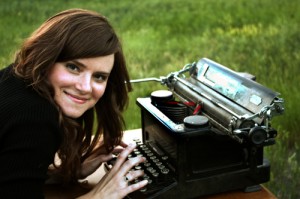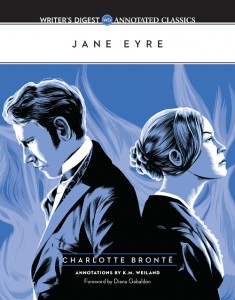If you haven’t discovered the talent and savvy of K.M. Weiland – you are in for a treat today!
Writing Epic Love Stories
Of all the story types, the love story is perhaps the most evergreen. After all, human beings are wired for love. Almost all of us
Reader relatability: check. Conflict: check. Sounds like the makings of a great story, doesn’t it?
But what transforms a romance from a fuzzy, feel-good romp to an epic love story? I’m talking bonds of destiny, thunder crashing in the background, life-and-death stakes, unforgettable romance. How do you write that kind of story?
I’m here to tell you that epic romance doesn’t get much better than Charlotte Brontë’s beloved classic Jane Eyre (which I analyze in-depth in my book Jane Eyre: The Writer’s Digest Annotated Classic). This story has all the above requirements—in spades. But what has made it so successful, memorable, and incredibly enduring? And how can you infuse the same ingredients into your own love story?
A Heroine Who Must Learn How to Love
The best love stories are about more than just love. They’re about life. We can’t extract love from its context, because it affects everything in our lives. A heroine whose only goal is to fall in love isn’t a three-dimensional or compelling character. Neither is a heroine whose external problems are all completely solved by the simple act of finding Mr. Right.
Jane Eyre has become an archetypal character thanks to her own merits, not just her romance with Rochester. Her story is fundamentally one of human worth. It asks, “Must someone earn the right to be loved through servitude?” Love is right there at the core of the story, but the story is also so much bigger. In the end, Jane can’t find happiness with Edward Rochester until she’s first learned to answer this question, claim personal empowerment, and be the mistress of her own life.
In the end, her love for Rochester doesn’t save her, even though it is instrumental in helping her get to the point where she can accept love on terms of equality. She gets to receive his love as a sort of reward only after she’s sorted out the central problems of her life.
A Larger-Than-Life Hero
What’s romance without a hunky hero? But to help his story reach epic status, a hero has be more than just a dish. He’s got to be more than a mere foil for the heroine in her journey. Indeed, he has to be at the epicenter of her transformation. Even though her journey is bigger than just her relationship with him, that relationship is ultimately the journey’s catalyst.
Both partners in an epic love story don’t necessarily have to undergo individual transformations. But the very fact that these two are destined to be soul mates means that when ones changes to any degree, both will be changed. When Jane meets her mysterious new employer Edward Rochester, he initially seems to have his life in much better order than she does hers. He has no problem claiming love or being the master of an entire household of servants.
But as the story progresses, we learn this charismatic and enigmatic man is even more deeply scarred and flawed than is Jane. He helps her figure out how to transform her life, but she also helps him. Indeed, the story is a surprisingly modern take on the love story. Jane is no damsel in distress waiting to be saved by a knight in shining armor. Each in their own ways, they rescue first themselves, then each other.
Tremendous Stakes
Love always comes with stakes. When you give your heart to someone, how can you be sure he won’t break it? But romantic stakes, by themselves, aren’t enough to raise your love story into epicness. What’s at stake for these characters needs to be more than just their love. Their happiness, their sanity, their very lives—even the survival of nations—needs to be on the line.
The heart of Jane Eyre is its love story. But as the classic Gothic novel, it’s about mystery and suspense as much as anything else. From the moment Jane arrives at Thornfield Hall, readers are overwhelmed with a sense of impending doom. Rochester’s secrets and Jane’s idolizing passion lead them to the brink of destruction. The Third Act finds Jane adrift, alone, and close to death. Rochester’s reputation, sanity, home, and life all go up in flames—literally.
These characters’ love for one another offers the possibility for great hope and joy. But if they can’t first get things right in their own lives, then the threat of even greater destruction hangs in the balance.

Romantic conflict offers all kinds of opportunities for plot development—but the romance author’s first responsibility is always to realism. Nothing turns off readers (and reduces the depth of your story) faster than petty, meaningless squabbles between lovers. If even just one scene in your story is based on the following types of conflict, rethink it:
- An argument about something unimportant without symbolizing something that really is important.
- A misunderstanding that could be cleared up with just a few quick questions and answers
- A misunderstanding that will be cleared up right away.
- Unnecessary pettiness on the part of either character.
If you’re struggling to find appropriate conflict in your story, dig for deeper stakes. What is your story really about? What is your character’s overall story goal? What obstacles can you place between her and that goal to create conflict meaningful to her relationship with the hero?
Very little of the conflict in Jane Eyre arises between Jane and Rochester. Most of it focuses on Jane’s inner need to claim personal empowerment and her impossible desire to love and be loved by her employer. Brontë never resorts to shallow, unrealistic conflict. Her characters are attracted to each other and then love each other—and their actions toward each other bear that out every step of the way.
Epic love stories like Jane Eyre have fired the imaginations of countless people over the centuries—and will continue to do so. As you sit down to work on your latest romance, consider how you can take it from ordinary to epic!
***
What aspects to do you think make an epic love story?
RU Founder Adrienne Giordano joins us Friday to share her Lessons Learned.
***
Bio:
K.M. Weiland lives in make-believe worlds, talks to imaginary friends, and survives primarily on chocolate truffles and espresso. She is the IPPY and NIEA Award-winning and internationally published author of the Amazon bestsellers Outlining Your Novel and Structuring Your Novel. She writes historical and speculative fiction from her home in western Nebraska and mentors authors on her award-winning website Helping Writers Become Authors.